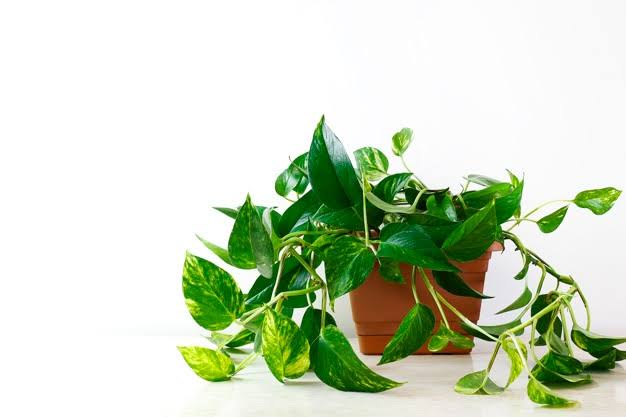Table of Contents
If you’re looking for an indoor plant as a newbie most nurseries would probably suggest a pothos plant. There are multiple reasons behind this suggestion but the most essential one is that this plant can be kept so easily. Pothos or Epipremnum aureum tend to have a hardy nature and can thrive anywhere. Pothos plants don’t need much attention and their growth is extremely easy to maintain. The only thing that can bother a plant owner, can be the yellow leaves of a pothos plant.
Beware, if you have a pothos pot lying around the house because their leaves can sometimes end up losing their lush green appearance. Let’s look at some possible causes behind the yellow appearance of your pothos plant and find out how you can fix that right away.
6 Reasons Behind Pothos Leaves Turning Yellow
Scenario 1: You Forgot About Repotting
The pothos plant often becomes root bounded when the pot becomes a little too small for its entire structure. In simple words, when the space provided to the roots becomes less adjustable its leaves can show signs of stunted growth by turning yellow. It’s a huge red flag that you haven’t repotted it into a new pot for a while. Another indicator that shows you haven’t repotted in a while is when the roots start poking through drainage holes.
Scenario 2: Pest Attacks & Bacterial Leaf Spots
As compared to other plants, Pothos plants tend to seem more immune to most issues. Yet, they’re not immune to pest attacks and bacterial leaf spots. You can detect bacterial leaf spots by taking a closer look at the leaves of pothos. If there seem to be halo-like structures around mushy spots on your leaves, then it’s a clear-cut bacterial leaf spot that can lead to the yellowing of pothos leaves. Similarly, mealybugs and spider mites often find their home around pothos plants. You can detect the presence of spider mites with their little white webs. Meanwhile, mealy bugs hide in the nooks and crannies of the pot.
Scenario 3: It’s A Case Of Root Rot
Pothos leaves are often under the radar of pathogens like; Fusarium & Pythium. These pathogens can cause root rot and indirectly lead to yellow pothos leaves. Now, a big question arises. How does one find out whether or not root rot has taken place?
You can simply check the presence of root rot by taking out pothos from its pot. Make sure you’re not being too harsh while taking it out and are supporting its base appropriately. If the roots seem firm and pale then your plant doesn’t have root rot. On the contrary, if the root ball seems pretty mushy, soft, and black in appearance then you’re dealing with root rot.
Scenario 4: Aging
Aging is a natural process in us and every other thing in the world. So, If you are noticing that most of the leaves seem to be in healthy condition yet a few have turned yellow. There’s a possibility that some of these are only going through the inevitable and are aging. These leaves might be shedding later on and there’s space being created for the new lush growth. There’s not much you can do in that case just make sure you’re using a nutritional fertilizer and your pothos plant is getting the nutrients it needs to flourish.
Scenario 5: Overwatering, Under-watering, and Scheduling Issues
Life is a race and there’s a whole lot to take care of. That’s why it’s quite possible that while you were dealing with other problems you might’ve forgotten to water your plants. Even in the cases when you remember to water them you might not be watering them properly because of diverted attention. The bottom line is it’s very easy to overwater and underwater a plant. Here are some classic signs that can help you realize whether you are dealing with something similar or not.
Pothos leaves give off dead giveaways through their vines and leaves. If the yellowish leaves of your pothos plant seem extra-crisp then they’re surely dehydrated and you’ve under-watering. Another dead giveaway would be a pothos plant’s droopy vines. They seem more bouncy only when they have enough water supply. If the yellow leaves on your pothos plant also seem to show brown spots then you might be overwatering them. Overwatering a pothos plant can lead to the yellowish appearance of the leaves as extra water remains on the surface of the soil diminishing the flow of oxygen towards the roots.
Now that we’ve moved past overwatering and under watering let’s move on to the most easily avoidable mistakes. Yes, we’re referring to the fact that most of all cannot help but miss out on our pothos plant’s watering schedule. That’s why your plant’s continuously under stress as the water density seems to be continuously altering. Make sure you’re being regular instead of overwatering on a few days and under-watering for an entire week. You simply can’t make up for that mistake.
Scenario 6: Mineral Deficiency
You surely won’t pop supplements for magnesium calcium deficiency if you’re affected with iron deficiency. Similarly, pothos plants need plant food that targets their exact need. If you’re causing a mineral overload then a pothos plant will show its signs through yellow leaves with brown spots on the top.
Pothos’ yellow leaves can also indicate that there’s a mineral deficiency that needs to be fulfilled. If the leaves are turning yellow on the corners but remain the same color in the center it’s a classic case of magnesium deficiency. Meanwhile, if the leaves in only the lower rows turn yellow then the plant has nitrogen deficiency.

Is It Possible To Rejuvenate Pothos’ Yellow Leaves?
Yellow pothos leaves do not indicate that your plant has a serious disease and it might die down any minute now. So yes, whether it’s something as common as aging or something as unusual as spider mites you can always rejuvenate this indoor plant.
Yet, it’s worth mentioning that the yellow leaves of your pothos plant might not turn back green. If you’re worried about leaf pruning then in some cases you can completely avoid that. You don’t have to trim off the yellow leaves of an aging pothos plant. Meanwhile, if root rot has taken place it’s essential that you trim off those yellow leaves and affected roots. Here’s how you can get rid of yellow leaves and avoid stunted growth in your pothos plant;
How To Take Care Of A Pothos Plant With Yellow Leaves?
- If you’re dealing with root rot and there are still some roots that seem firm, you can maneuver your way out of this issue. Simply take out pothos from its old pot and wash them under lukewarm water. The next step is to wash its old pot with a diluted solution of bleach and water. Consequently, any remaining pathogens in the pot will reach their demise. Throw away the soil that was being used previously and add freshly aerated soil to the pot. Before planting the roots once again make sure you treat them with fungicide and don’t forget to do some leaf pruning. Pruning the leaves will ensure that there are no remaining yellow leaves. Moreover, it’ll make the presence of leaves over the roots less taxing.
- Give your pothos leaves a break from excessive sunlight. Just like we as humans can’t handle too much sunlight and shake at the thought of an unmanageable tan, pothos leaves also can’t bear to be a witness to too much sun. Move the pot to a location where moderate sunlight reaches or place a sheet curtain between the pot and the window you’ve placed it against.
- If it’s a clear-cut case of spider mites and mealybugs then you can wash off their webs with water. Just prune the affected leaves and treat the plant with an insecticide.
- To avoid yellowish leaves in general make sure you’re aerating the soil every now and then. Use a pointy object to poke holes in the surface of the soil and wait for the water to pass through those holes. While poking the soil avoid poking the roots or shoots.
- If the yellow leaves are an indicator of mineral overload switch up to distilled water while watering plants. You can also collect rainwater in a bucket or simply leave out a filled water jug to use on your plants that next morning. During the night nutrients will evaporate from the jug and make it appropriate for usage the next day.
- Use water-soluble fertilizer on your pothos plant every month as it can put a stop to yellow leaves and stunted growth.
- To avoid missing out on scheduling sessions make sure you’re setting an alarm every day. Even after setting an alarm, you don’t have to water your pothos plant every day. First, make sure that your pothos plant actually needs water today. If the stems seem a little droopy and not curly in the upwards direction then it’s time for water for sure. You can even touch the soil and feel its dryness just to be sure.
- Repot the pothos plants every once in a while to avoid yellow leaves.
- After wearing the plant each time ensure that extra water is flowing through the drainage hole into the saucer. Letting pothos plants sit in water can be detrimental and result in yellow leaves in the future.
- While you’re watering a pothos plant avoid striking the leaves as it can lead to bacterial leaf spots. Instead, pour the water directly onto the soil to avoid yellow pothos leaves in the future.
- If you’re dealing with an overwatered Pothos plant then the damage can still be reversed. You can begin by clipping off any yellow leaves on the plant and pruning the wilted edges. Make sure that you move the pot to a sunny location so that the water dries out and oxygen absorption becomes much easier for the roots. Certain kinds of soils tend to hold on to moisture for a longer period which can also result in overwatering. In that case, you can add perlite or some other kind of coarse sand to maintain equilibrium. If you can’t move it into a sunnier location make sure that the drainage is appropriate in the soil. Poke some more drain holes in the soil.
- Of course, if you have personally taken care of drainage you might be sure that your pothos plants will not face any other troubles related to aeration. Yet the trouble hasn’t ended yet my friend. Some kinds of soil do not allow proper aeration that’s why it’s necessary to use a well-aerated medium in the first place. Sandy soils generally allow more aeration.
Final Words
Now you’ve got the key to the lock as you’ve got to know about all possible reasons behind yellow pothos leaves. Before we end this discourse you need to know that some pothos plants naturally have yellow specks on their leaves. A great example of this would be the marble queen pothos. So, just make sure you’re not worrying without a cause. Like any other plant owner you just need to act on the well-known 4 pointer rule; proper watering, on-time nutrition, moderate sunlight, and optimal aeration!
Consult a local gardener or nursery to discover your options for a water-soluble fertilizer and well-aerated soil. Make sure you’re not going a little too overboard with watering and your pothos plant will thrive on its own.







